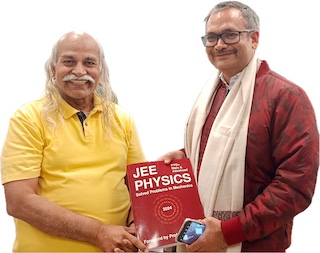First Law of Thermodynamics and its Applications
Internal energy (U) of a system is the sum of molecular kinetic and potential energies in the centre of mass reference frame. It is a state variable (p, V and T are other state variables). The change in internal energy in a cyclic process is zero. Heat (Q) is energy in transit.
The first law of thermodynamics is a statement of conservation of energy. According to the first law, the heat $\Delta Q$ supplied to a system is sum of the increase in internal energy $\Delta U$ of the system and work done by the system i.e., \begin{align} \Delta Q=\Delta U+\Delta W \end{align} The first law of thermodynamics for a cyclic process reduces to $\Delta Q=\Delta W$ (because $\Delta U=0$ in a cyclic process).
Solved Problems from IIT JEE
Problem from IIT JEE 2014
A thermodynamic system is taken from an initial state i with internal energy $U_\text{i}=100\;\mathrm{J}$ to the final state f along two different paths iaf and ibf, as schematically shown in the figure.
Solution: In a thermodynamics process, the heat supplied to the system, the increase in internal energy of the system, and the work done by the system are related by the first law of thermodynamics,
\begin{align} \Delta Q=\Delta U+\Delta W. \end{align}The first law of thermodynamics for the process iaf gives, \begin{align} \label{hxb:eqn:1} Q_\text{iaf}=U_\text{iaf}+W_\text{iaf}=(U_\text{f}-U_\text{i})+(W_\text{ia}+ W_\text{af}). \end{align} Substitute $Q_\text{iaf}={500}\mathrm{J}$, $U_\text{i}={100}\;\mathrm{J}$, $W_\text{ia}=0$ (constant volume), and $W_\text{af}={200}\mathrm{J}$ to get $U_\text{f}={400}\;\mathrm{J}$.
In the process ib, \begin{align} \label{hxb:eqn:2} Q_\text{ib}= U_\text{ib}+ W_\text{ib}=(U_\text{b}-U_\text{i})+ W_\text{ib}. \end{align} Substitute $U_\text{b}={200}\;\mathrm{J}$, $U_\text{i}={100}\;\mathrm{J}$, and $W_\text{ib}={50}\;\mathrm{J}$ to get $Q_\text{ib}={150}\;\mathrm{J}$.
In the process bf, \begin{align} \label{hxb:eqn:3} Q_\text{bf}=U_\text{bf}+ W_\text{bf}=(U_f-U_b)+ W_\text{bf}. \end{align} Substitute $U_\text{f}={400}\;\mathrm{J}$, $U_\text{b}={200}\;\mathrm{J}$ and $W_\text{bf}={100}\;\mathrm{J}$ to get $Q_\text{bf}={300}\;\mathrm{J}$. Thus, $Q_\text{bf}/Q_\text{ib}=300/150=2$.
Problem from IIT JEE 2001
In a given process of an ideal gas, $\text{d}W=0$ and $\text{d}Q<0$. Then for the gas,
- the temperature will decrease.
- the volume will increase.
- the pressure will remain constant.
- the temperature will increase.
Solution: First law of thermodynamics, $\mathrm{d}Q=\mathrm{d}U+\mathrm{d}W$, gives $\mathrm{d}U<0$. For an ideal gas, internal energy decreases due to decrease in temperature.
Questions on First Law of Thermodynamics
Question 1: One gram of water is vaporized at 100 deg C and atmospheric pressure. The volume water increases from 1 cm3 to 1671 cm3 in this process. If latent heat of vaporization is 2256 J/g then which of the following statement in wrong?
Question 2: Which of the following statement is meaningful/correct?
Question 3 (based on NCERT): Which of the following statement is not true?
